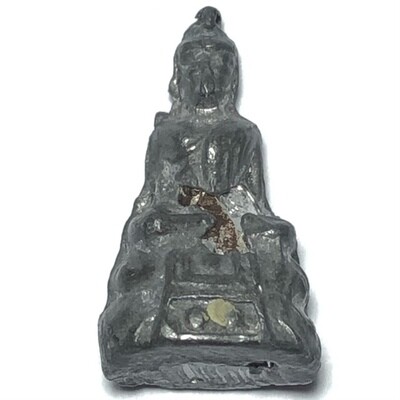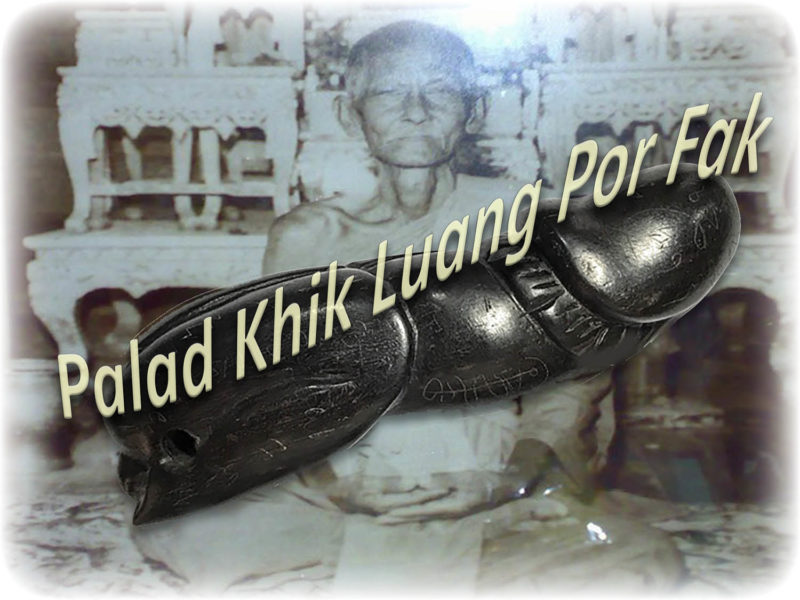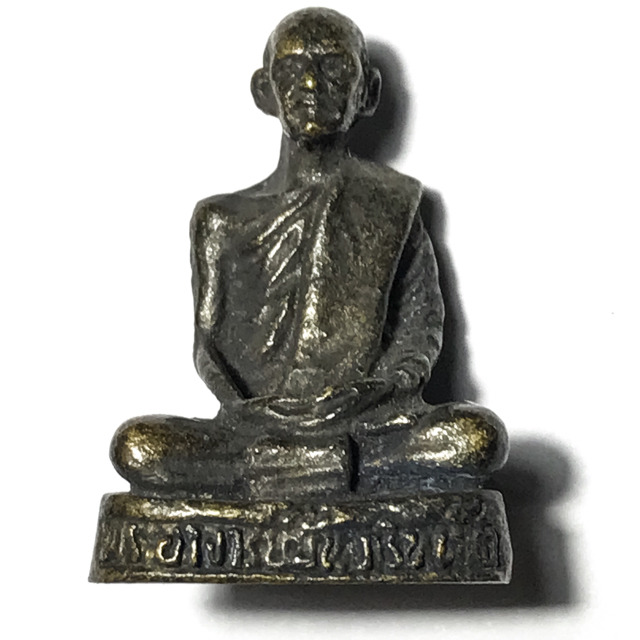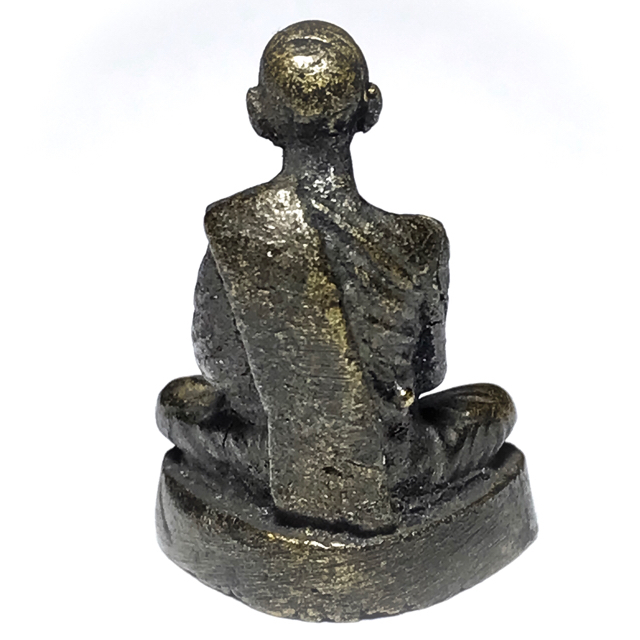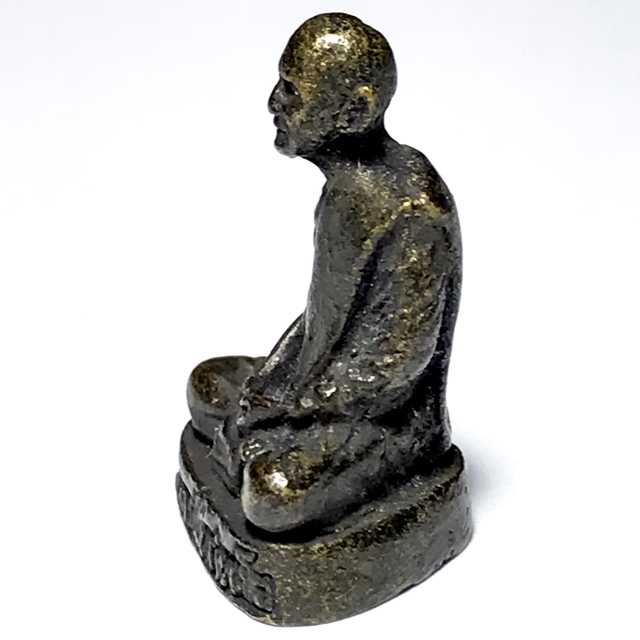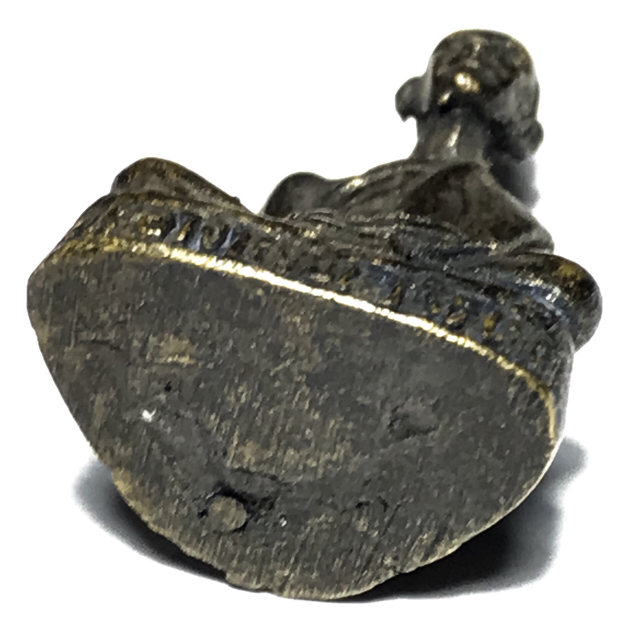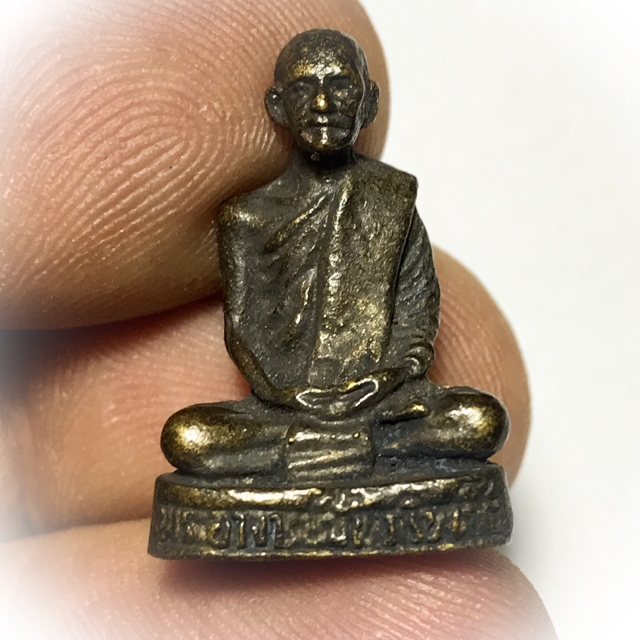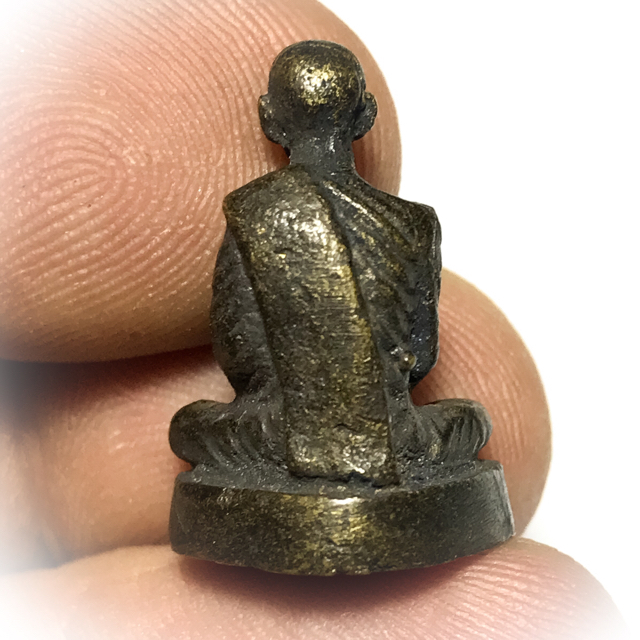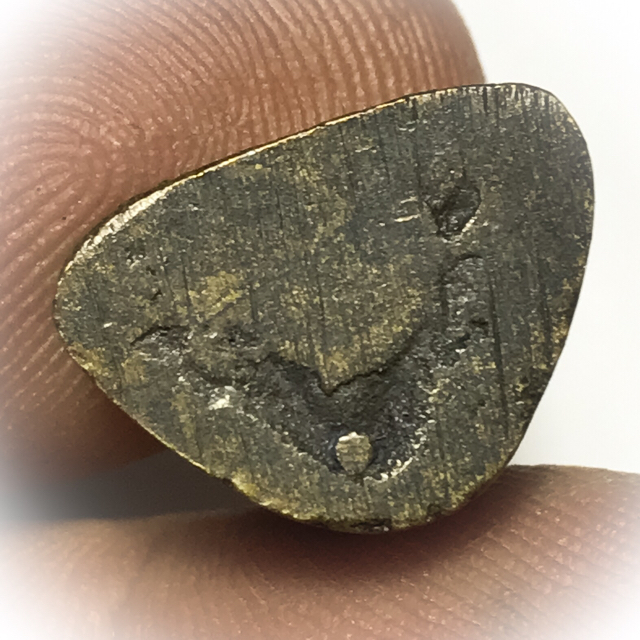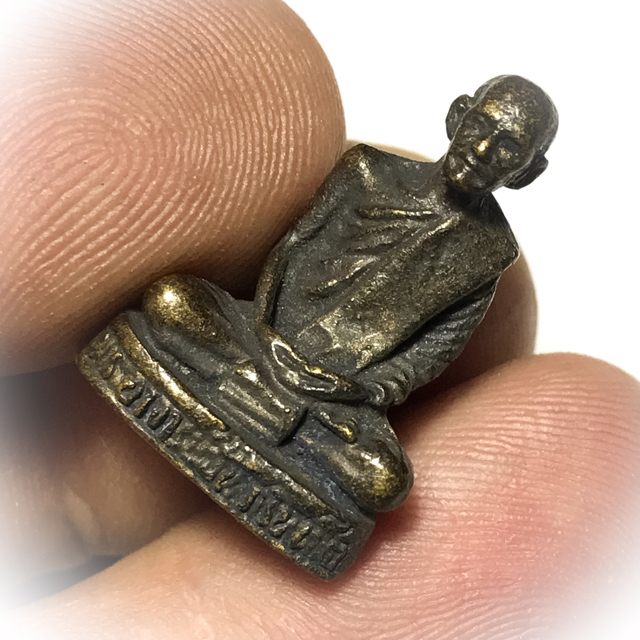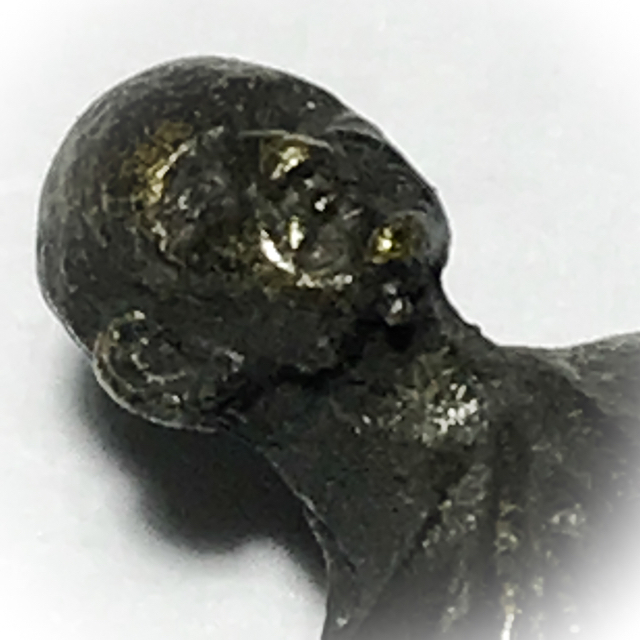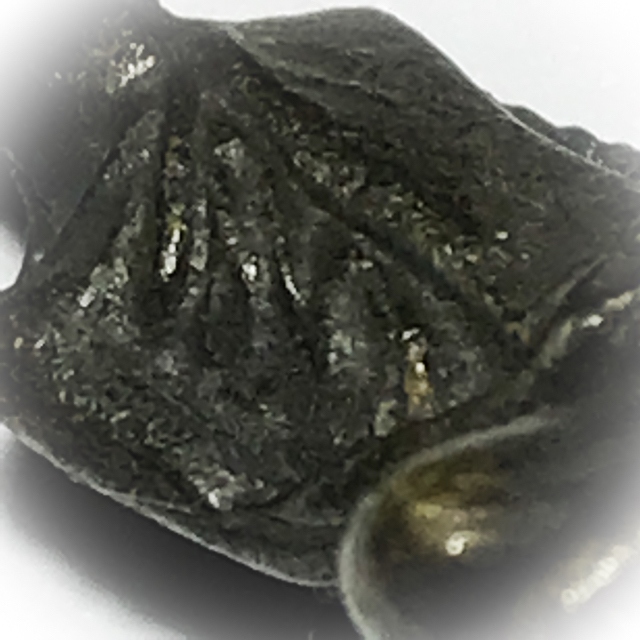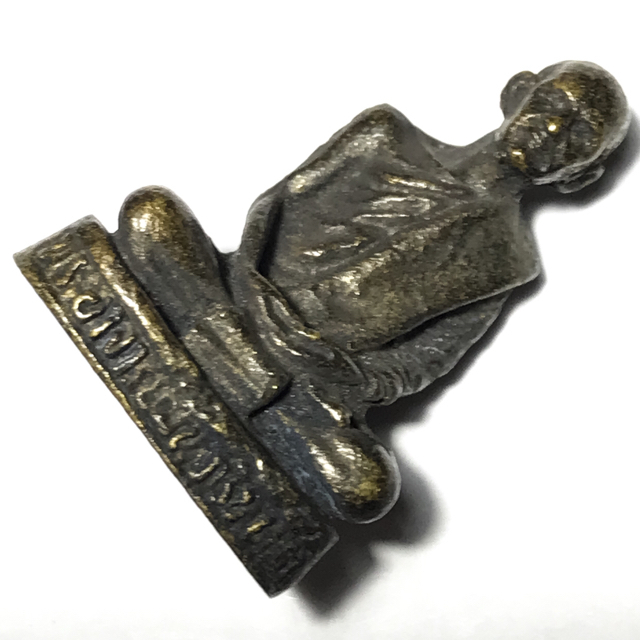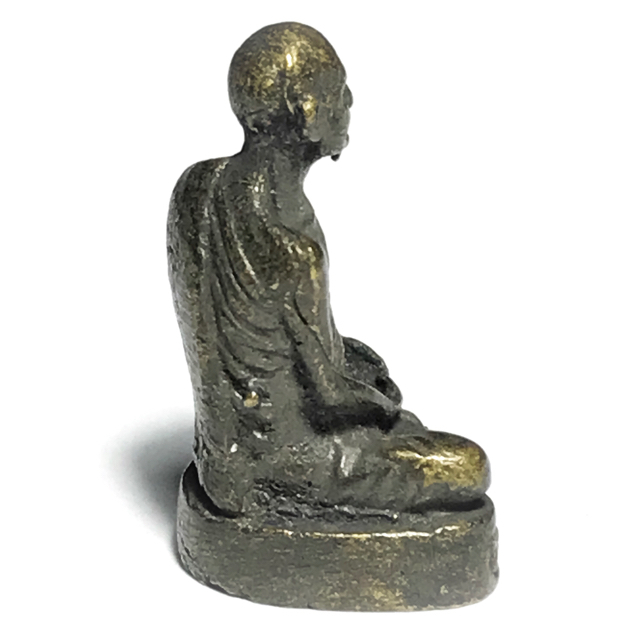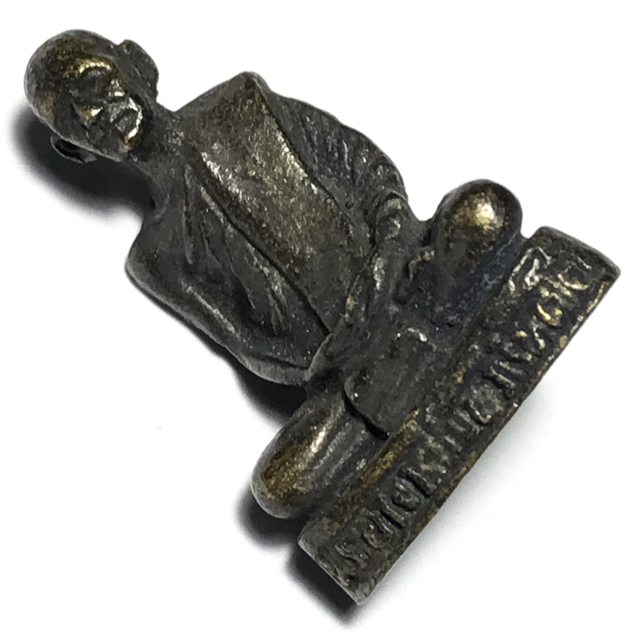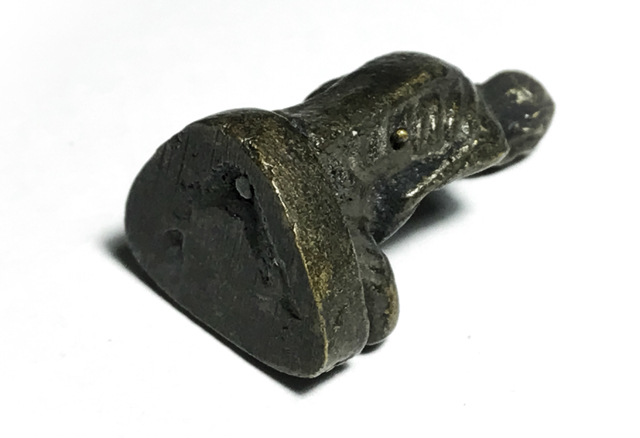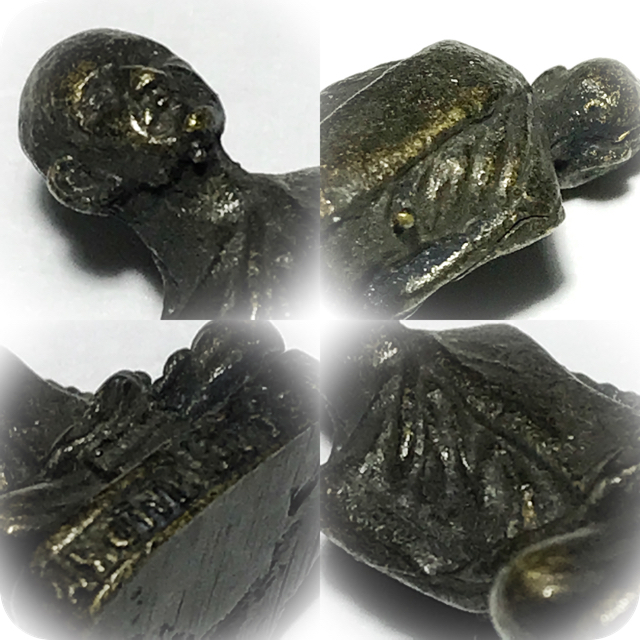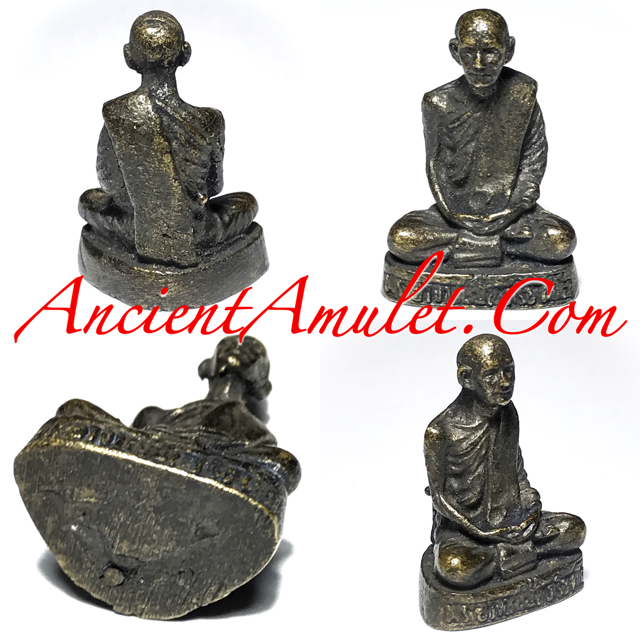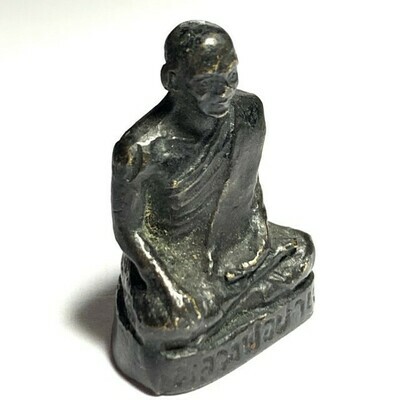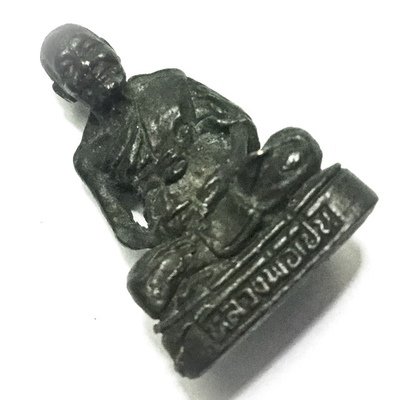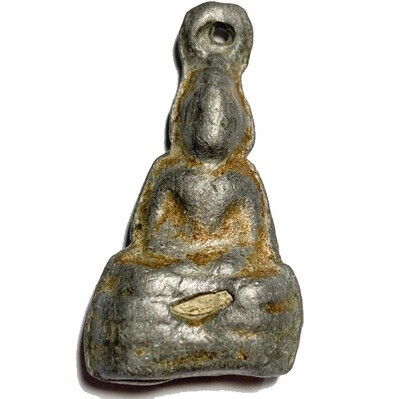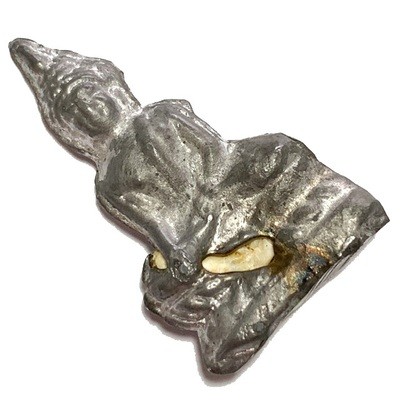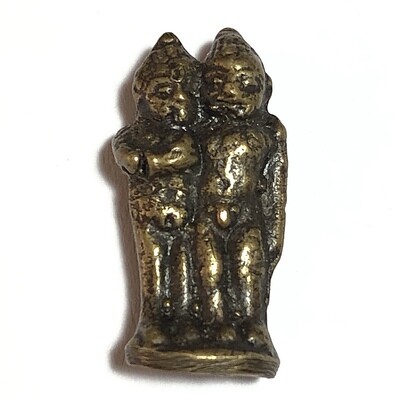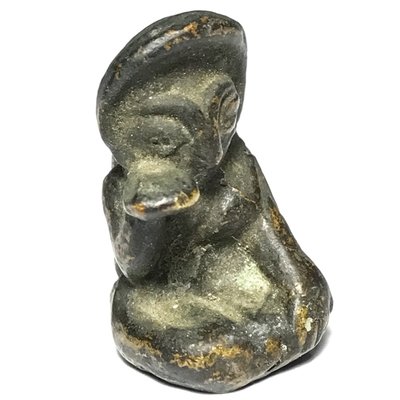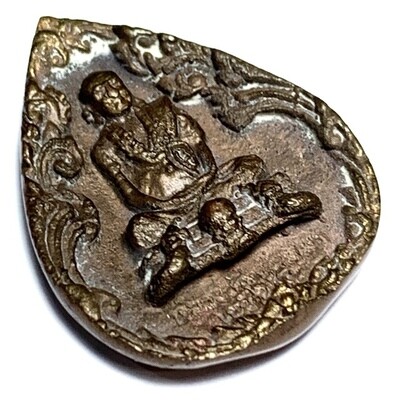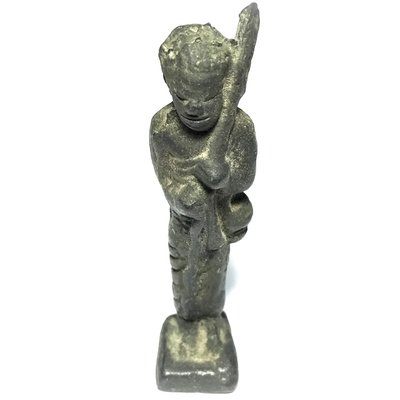One of the rarest and most highly revered and sought after Palad Khik of all Time, the Palad Khik Gae Nuea Mai Paya Ngiw Dam Dong Jarn Mer, of Luang Por Fak, of Wat Nikom Prachasan. Hand carved from sacred Deva inhabited black Ngiw treewood. The Palad Khik of Luang Por Fak is considered amongst the top five Palad Khik of all time, and carries Supreme Eminence in the Thai Collector Scene of the Krueang Rang Category, and for all Devotees of Palad Khik amulets.
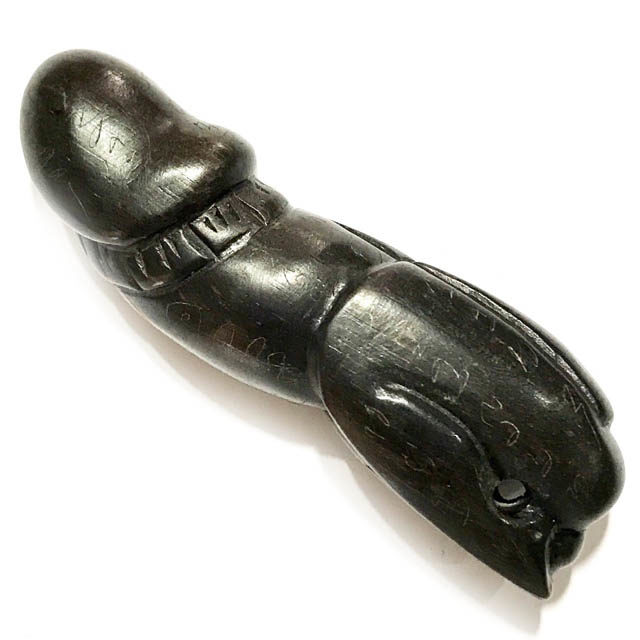
Palad Khik Mai Ngiw Dam Dong LP Fak with Hand Spell Inscriptions
Little is known of his Biography or Life before ordination, but it is known that he was the apprentice in Wicha to the great Luang Por Soke (also top 5 Palad Khik Master), and was the4 Kroo Ba Ajarn who taught the Wicha Palad Khik to the Great Luang Por Yid, of Wat Nong Jork. This Palad Khik from Luang Por Fak is in Pristine condition and exquisitely carved in the classic uniquitious curved shape which has come to be a trademark with the Palad Khik of Luang Por Fak.
A hole is drilled through the base of the Palad Khick for threading a cord through and attaching to a waistcord belt, or can alternatively be encased in waterproof casing with pendant hoop for wearing on a neckchain or belt as preferred.
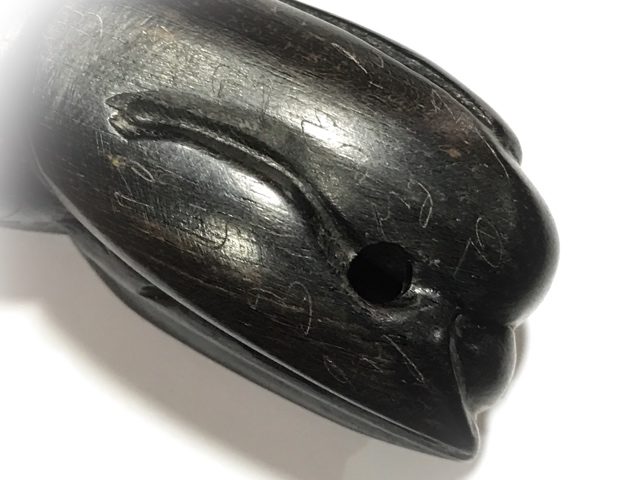
Hole drilled in base of Palad Khik Mai Ngiw Dam Dong LP Fak, for threading a cord for attachment to a belt or neckchain – Hand spell inscriptions can be seen on the surface of the sacred black Paya Ngiw Dam Dong Treewood.
The back of the Palad Khik has three holes where special Muan Sarn is inserted. The body of the the Palad Khik is formed in the clasic curved shape which has become known to be ubiquitous with the Palad Khik of this Master. This exhibit is extremely rare for the hand inscription of the Yant Dan Dta (Yant Dto) on the head of the Palad Khik, which is said to be found on only very rarely.
The Palad Khik of Luang Por Fak are highly renowned for Kong Grapan Chadtri (Invincibility), Klaew Klaad (Evasion of Deadly Accidents), Metta Maha Niyom n(Mercy Charm), Kaa Khaay (Selling Power), and Lai Phuudt Phii Pisaj (Chase Demons and Ghosts Away).

3 Muan Sarn Inserts in the Palad Khik Mai Ngiw Dam Dong LP Fak
The Palad Khik is empowered with the Kata; NA HI HA HU JA CHA DAN DTA
And the Kata Hua Jai Taw Waes Suwan “WAE SA PU SA”, and the Kata Hua Jai Ittijae for Metta Maha Sanaeh “I TA KA MA”, as well as the Kata Hua Jai Metta Karaniya Sutta “AE DTANG SA DTING”, topped off with the Hua Jai Maha Ud “UT TANG AD TO”.
11 Kinds of Blessings are included within the Magic of the Palad Khik’s Wicha; 1. Sleep peacefully, 2. Awaken with Happiness, 3. Protection against all Deadly Weaponry, 4. Immunity to Poisons, 5. Mercy Charm, 6. Good Business and Wealth Increase, 7. Convincing Speech, 8. Ward off Evil Spirits and Ghosts, 9. Improve Karma, 10. Protect Household and Property, 11. Increase Popularity & Chances of Promotion.

Palad Khik Mai Ngiw Dam Dong LP Fak
The Palad Khik is an Ancient Wicha, whose development can be traced right back to the Vedic Brahman Occult practices of Thousands of Years ago. Palad Khik amulets must be empowered by the repetition of incantations, which Thais call ‘Kata Bucha’, derived from the Devanagari ‘ghata poojah’. The incantations depend on the creator’s lineage in each school of traditional non-Buddhist animist magic.
Kata Bucha Palad Khik
Ganha Neha Na Ma Pa Ta
or
Ja Pa Ga Sa Na Mo Put Taa Ya Gan Ha Nae Ha Na Ma Pa Ta
or
Om Siwaling Sabbha Metta Sabbha Pokaa Sabbha Laapo Sabbha Tanaa, Sabbha Yasa, Sabbha Pranee Sabbha Mangalaani Bhavantume.
or
Om Laluay Mahaa Laluay Samsip Sorng Hee Hae Hom Lorm Dtorm Kuay Khor Hai Guu Ram Ruay Pro Hua Kuay An Nii Da Daa Di Dii Duu Dii Hee Maa Kuay Maa Burut Maa Dii Sadtrii Mii Maa Swaa Home
chant any one, or all of the Kata 3 times holding the Palad Khik before wearing
Roop Lor Luang Phu Mun Wat Pha Sutawat 2513 BE - Nuea Rakang Gao Released at Wat Pha Sum Namai
Sacred Guru Monk statuette, The Roop Lor Nuea Rakang Gao Image of Luang Phu Mun Puritadto of Wat Pha Sutawas was released in the same edition and ceremony as the famed Rian Luang Phu Mun 2513 BE Guru Monk Coin Amulet, which is so highly sought after as a highly sacred amulet, blessed by some of the greatest Masters of the time in Mass Buddha Abhiseka.
The statuette is forged from Nuea Rakang Gao smelted from an ancient Brass Temple Bell. Temple Bells are seen to be sacred artifacts, and to possess powerful vibrations from the ritual ringing of the bell by monks. The statuette has the words 'Pra Ajarn Mun Puritadto' on the front of the base of the amulet, with Luang Phu Mun seated in meditation above.
The amulets were released in the year 2513-2514 BE in a very special Buddha Abhiseka, at the temple of Wat Sum Namai in Khon Gaen, with a large number of some of the greatest Guru Masters of the time present to empower, including; Luang Phu Doon Udtalo (Wat Burapharam, Surin), Luang Phu Khaw Analayo (Wat Tham Gong Plae, Udorn Thani), Luang Phu Fan Ajaro, Luang Phu Tet, Taesrangsri, Luang Phu Hwaen (Wat Doi Mae Pang), Luang Phu Phang Jidtakudto, Luang Phu Pra Maha So Kassapo, and Luang Phu Nin Mahandtabanyo.
Ajarn Mun Bhuridatta Thera (Thai: มั่น ภูริทตฺโต, rtgs: Ajarn Man Phurithatto; Lao: ຫຼວງປູ່ມັ່ນ ພູຣິທັຕໂຕ), 1870–1949, was a Thai bhikkhu of Lao descent who is credited, along with his mentor, Ajarn Sao Kantasīlo, with establishing the Thai Forest Tradition or "Kammaṭṭhāna tradition" that subsequently spread throughout Thailand and to several countries abroad. Ajarn Mun was born in Baan Kham Bong, a farming village in Ubon Ratchathani Province, Isan. Ordained as a monk in 1893, he spent the remainder of his life wandering through Thailand, Burma, and Laos, dwelling for the most part in the forest, engaged in the practice of meditation. He attracted an enormous following of students and, together with his teacher, Sao Kantasīlo (1861–1941), established the Thai Forest Tradition (the kammaṭṭhāna tradition) that subsequently spread throughout Thailand and to several countries abroad. He died at Wat Suddhavasa, Sakon Nakhon Province.
Ajarn Mun was born in Baan Kham Bong, a farming village in Ubon Ratchathani Province, Isan. Ordained as a monk in 1893, he spent the remainder of his life wandering through Thailand, Burma, and Laos, dwelling for the most part in the forest, engaged in the practice of meditation. He attracted an enormous following of students and, together with his teacher, Sao Kantasīlo (1861–1941), established the Thai Forest Tradition (the kammaṭṭhāna tradition) that subsequently spread throughout Thailand and to several countries abroad. He died at Wat Suddhavasa, Sakon Nakhon Province. (Wikipedia)
We would like to share a passage written by Luang Por Thanissaro Bhikkhu (Ajarn Geoffrey de-Graaf), who wrote a most explanatory essay of the role of the Great Ajarn Mun in the revival of the true Buddhist Practice and the Rise of the Thai Tudong Kammathana Forest tradition;
"Throughout its history, Buddhism has worked as a civilizing force. Its teachings on karma, for instance — the principle that all intentional actions have consequences — have taught morality and compassion to many societies. But on a deeper level, Buddhism has always straddled the line between civilization and wilderness. The Buddha himself gained Awakening in a forest, gave his first sermon in a forest, and passed away in a forest. The qualities of mind he needed in order to survive physically and mentally as he went, unarmed, into the wilds, were key to his discovery of the Dhamma. They included resilience, resolve, and alertness; self-honesty and circumspection; steadfastness in the face of loneliness; courage and ingenuity in the face of external dangers; compassion and respect for the other inhabitants of the forest.
These qualities formed the "home culture" of the Dhamma. Periodically, as Buddhism spread and adapted to different societies, some practitioners felt that the original message of the Dhamma had become diluted. So they returned to the wilderness in order to revive its home culture. Many wilderness traditions are still alive today, especially in the Theravada countries of Sri Lanka and Southeast Asia. There, mendicant ascetic monks continue to wander through the remaining rainforests, in search of Awakening in the same environment where the Buddha found Awakening himself. Among these wilderness traditions, the one that has attracted the largest number of Western students, and is beginning to take root in the West, is the Kammatthana (Meditation) Forest tradition of Thailand. The Kammatthana tradition was founded by Ajarn Mun Bhuridatto in the early decades of this century. Ajarn Mun's mode of practice was solitary and strict. He followed the Vinaya (monastic discipline) faithfully, and also observed many of what are known as the thirteen classic dhutanga (ascetic) practices, such as living off almsfood, wearing robes made of cast-off rags, dwelling in the forest, eating only one meal a day.
Searching out secluded places in the wilds of Thailand and Laos, he avoided the responsibilities of settled monastic life and spent long hours of the day and night in meditation. In spite of his reclusive nature, he attracted a large following of students willing to put up with the hardships of forest life in order to study with him. He also had his detractors, who accused him of not following traditional Thai Buddhist customs. He usually responded by saying that he wasn't interested in bending to the customs of any particular society — as they were, by definition, the customs of people with greed, anger, and delusion in their minds. He was more interested in finding and following the Dhamma's home culture, or what he called the customs of the noble ones: the practices that had enabled the Buddha and his disciples to achieve Awakening in the first place.
This phrase — the customs of the noble ones — comes from an incident in the Buddha's life: not long after his Awakening, he returned to his home town in order to teach the Dhamma to the family he had left six years earlier. After spending the night in a forest, he went for alms in town at daybreak. His father the king learned of this and immediately went to upbraid him. "This is shameful," the king said. "No one in the lineage of our family has ever gone begging. It's against our family customs." "Your majesty," the Buddha replied, "I now belong, not to the lineage of my family, but to the lineage of the noble ones. Theirs are the customs I follow." Ajarn Mun devoted many years of his life to tracking those customs down. Born in 1870, the son of rice farmers in the northeastern province of Ubon, he was ordained as a monk in the provincial capital in 1892. At the time of his ordination, there were two broad types of Buddhism available in Thailand.
The first can be called Customary Buddhism — the mores and rites handed down over the centuries from teacher to teacher with little, if any, reference to the Pali canon. For the most part, these customs taught monks to live a sedentary life in the village monastery, serving the local villagers as doctors or fortune tellers. Monastic discipline tended to be loose. Occasionally, monks would go on a pilgrimage they called "dhutanga" which bore little resemblance to the classic dhutanga practices. Instead, it was more an undisciplined escape valve for the pressures of sedentary life. Moreover, monks and lay people practiced forms of meditation that deviated from the path of tranquillity and insight outlined in the Pali canon. Their practices, called vichaa aakhom, or incantation knowledge, involved initiations and invocations used for shamanistic purposes, such as protective charms and magical powers. They rarely mentioned nirvana except as an entity to be invoked for shamanic rites. The second type of Buddhism available at the time was Reform Buddhism, based on the Pali canon and begun in the 1820's by Prince Mongkut, who later became King Rama IV (and still later was portrayed in the musical The King and I).
Prince Mongkut was ordained as a monk for twenty-seven years before ascending the throne. After studying the canon during his early years as a monk, he grew discouraged by the level of practice he saw around him in Thai monasteries. So he reordained among the Mons — an ethnic group that straddled the Thai-Burmese border and occupied a few villages across the river from Bangkok — and studied Vinaya and the classic dhutanga practices under the guidance of a Mon teacher. Later, his brother, King Rama III, complained that it was disgraceful for member of the royal family to join an ethnic minority, and so built a monastery for the Prince-Monk on the Bangkok side of the river. There, Mongkut attracted a small but strong following of like-minded monks and lay supporters, and in this way the Dhammayut (lit., In Accordance with the Dhamma) movement was born.
In its early years, the Dhammayut movement was an informal grouping devoted to Pali studies, focusing on Vinaya, the classic dhutanga practices, a rationalist interpretation of the Dhamma, and the revival of meditation techniques taught in the Pali canon, such as recollection of the Buddha and mindfulness of the body. None of the movement's members, however, could prove that the teachings of the Pali canon actually led to enlightenment. Mongkut himself was convinced that the path to nirvana was no longer open, but he felt that a great deal of merit could be made by reviving at least the outward forms of the earliest Buddhist traditions. Formally taking a bodhisattva vow, he dedicated the merit of his efforts to future Buddhahood. Many of his students also took vows, hoping to become disciples of that future Buddha.
Upon disrobing and ascending the throne after his brother's death in 1851, Rama IV was in a position to impose his reforms on the rest of the Thai Sangha, but chose not to. Instead, he quietly sponsored the building of new Dhammayut centers in the capital and the provinces, which was how — by the time of Ajarn Mun — there came to be a handful of Dhammayut monasteries in Ubon. Ajarn Mun felt that Customary Buddhism had little to offer and so he joined the Dhammayut order, taking a student of Prince Mongkut as his preceptor. Unlike many who joined the order at the time, he wasn't interested in the social advancement that would come with academic study and ecclesiastical appointments. Instead, his life on the farm had impressed on him the sufferings inherent in the cycle of life and death, and his single aim was to find a way out of the cycle. As a result, he soon left the scholarly environment of his preceptor's temple and went to live with a teacher named Ajarn Sao Kantasilo (1861-1941) in a small meditation monastery on the outskirts of town.
Ajarn Sao was unusual in the Dhammayut order in that he had no scholarly interests but was devoted to the practice of meditation. He trained Ajarn Mun in strict discipline and canonical meditation practices, set in the context of the dangers and solitude of the wilderness. He could not guarantee that this practice would lead to the noble attainments, but he believed that it headed in the right direction. After wandering for several years with Ajarn Sao, Ajarn Mun set off on his own in search of a teacher who could show him for sure the way to the noble attainments. His search took nearly two decades and involved countless hardships as he trekked through the jungles of Laos, central Thailand, and Burma, but he never found the teacher he sought. Gradually he realized that he would have to follow the Buddha's example and take the wilderness itself as his teacher, not simply to conform to the ways of nature — for nature is samsara itself — but to break through to truths transcending them entirely. If he wanted to find the way beyond aging, illness, and death, he would have to learn the lessons of an environment where aging, illness, and death are thrown into sharp relief. At the same time, his encounters with other monks in the forest convinced him that learning the lessons of the wilderness involved more than just mastering the skills of physical survival.
He would also have to develop the acuity not to be misled by dead-end sidetracks in his meditation. So, with a strong sense of the immensity of his task, he returned to a mountainous region in central Thailand and settled alone in a cave. In the long course of his wilderness training, Ajarn Mun learned that — contrary to Reform and Customary beliefs — the path to nirvana was not closed. The true Dhamma was to be found not in old customs or texts but in the well-trained heart and mind. The texts were pointers for training, nothing more or less. The rules of the Vinaya, instead of simply being external customs, played an important role in physical and mental survival. As for the Dhamma texts, practice was not just a matter of confirming what they said. Reading and thinking about the texts could not give an adequate understanding of what they meant — and did not count as showing them true respect. True respect for the texts meant taking them as a challenge: putting their teachings seriously to the test to see if, in fact, they are true. In the course of testing the teachings, the mind would come to many unexpected realizations that were not contained in the texts. These in turn had to be put to the test as well, so that one learned gradually by trial and error to the point of an actual noble attainment. Only then, Ajarn Mun would say, did one understand the Dhamma.
This attitude toward the Dhamma parallels what ancient cultures called "warrior knowledge" — the knowledge that comes from developing skills in difficult situations — as opposed to the "scribe knowledge" that people sitting in relative security and ease can write down in words. Of course, warriors need to use words in their training, but they view a text as authoritative only if its teachings are borne out in practice. The Canon itself encourages this attitude when it quotes the Buddha as teaching his aunt, "As for the teachings of which you may know, 'These teachings lead to dispassion, not to passion; to being unfettered, not to being fettered; to divesting, not to accumulating; to modesty, not to self-aggrandizement; to contentment, not to discontent; to seclusion, not to entanglement; to aroused persistence, not to laziness; to being unburdensome, not to being burdensome': You may definitely hold, 'This is the Dhamma, this is the Vinaya, this is the Teacher's instruction.'" Thus the ultimate authority in judging a teaching is not whether the teaching can be found in a text. It lies in each person's relentless honesty in putting the Dhamma to the test and carefully monitoring the results. When Ajarn Mun had reached the point where he could guarantee that the path to the noble attainments was still open, he returned to the northeast to inform Ajarn Sao and then to continue wandering.
Gradually he began to attract a grassroots following. People who met him were impressed by his demeanor and teachings, which were unlike those of any other monks they had known. They believed that he embodied the Dhamma and Vinaya in everything he did and said. As a teacher, he took a warrior's approach to training his students. Instead of simply imparting verbal knowledge, he put them into situations where they would have to develop the qualities of mind and character needed in surviving the battle with their own defilements. Instead of teaching a single meditation technique, he taught them a full panoply of skills — as one student said, "Everything from washing spittoons on up" — and then sent them into the wilds. It was after Ajarn Mun's return to the northeast that a third type of Buddhism emanating from Bangkok — State Buddhism — began to impinge on his life. In an effort to present a united front in the face of imperialist threats from Britain and France, Rama V (1868-1910) wanted to move the country from a loose feudal system to a centralized nation-state. As part of his program, he and his brothers — one of whom was ordained as a monk — enacted religious reforms to prevent the encroachment of Christian missionaries. Having received their education from British tutors, they created a new monastic curriculum that subjected the Dhamma and Vinaya to Victorian notions of reason and utility.
Their new version of the Vinaya, for instance, was a compromise between Customary and Reform Buddhism designed to counter Christian attacks that monks were unreliable and lazy. Monks were instructed to give up their wanderings, settle in established monasteries, and accept the new state curriculum. Because the Dhammayut monks were the best educated in Thailand at the time — and had the closest connections to the royal family — they were enlisted to do advance work for the government in outlying regions. In 1928, a Dhammayut authority unsympathetic to meditation and forest wanderers took charge of religious affairs in the northeast. Trying to domesticate Ajarn Mun's following, he ordered them to establish monasteries and help propagate the government's program. Ajarn Mun and a handful of his students left for the north, where they were still free to roam. In the early 1930's, Ajarn Mun was appointed the abbot of an important monastery in the city of Chieng Mai, but fled the place before dawn of the following day.
He returned to settle in the northeast only in the very last years of his life, after the local ecclesiastical authorities had grown more favorably disposed to his way of practice. He maintained many of his dhutanga practices up to his death in 1949. It wasn't until the 1950's that the movement he founded gained acceptance in Bangkok, and only in the 1970's did it come into prominence on a nationwide level. This coincided with a widespread loss of confidence in state monks, many of whom were little more than bureaucrats in robes. As a result, Kammatthana monks came to represent, in the eyes of many monastics and lay people, a solid and reliable expression of the Dhamma in a world of fast and furious modernization. Buddhist history has shown that wilderness traditions go through a very quick life cycle.
As one loses its momentum, another often grows up in its place. But with the wholesale destruction of Thailand's forests in the last few decades, the Kammatthana tradition may be the last great forest tradition that Thailand will produce. Fortunately, we in the West have learned of it in time to gather lessons that will be help in cultivating the customs of the noble ones on Western soil and establishing authentic wilderness traditions of our own. Perhaps the most important of those lessons concerns the role that the wilderness plays in testing and correcting trends that develop among Buddhists in cities and towns. The story of the Kammatthana tradition gives lie to the facile notion that Buddhism has survived simply by adapting to its host culture. The survival of Buddhism and the survival of the Dhamma are two different things. People like Ajarn Mun — willing to make whatever sacrifices are needed to discover and practice the Dhamma on its own terms — are the ones who have kept the Dhamma alive.
Of course, people have always been free to engage in Buddhist traditions in whatever way they like, but those who have benefited most from that engagement are those who, instead of reshaping Buddhism to fit their preferences, reshape themselves to fit in with the customs and traditions of the noble ones. To find these customs isn't easy, given the bewildering variety of traditions that Buddhists have spawned over the centuries. To test them, each individual is thrown back on his or her own powers of relentless honesty, integrity, and discernment. There are no easy guarantees. And perhaps this fact in itself is a measure of the Dhamma's true worth. Only people of real integrity can truly comprehend it. As Ajarn Lee, one of Ajarn Mun's students, once said, "If a person isn't true to the Buddha's teachings, the Buddha's teachings won't be true to that person — and that person won't be able to know what the Buddha's true teachings are. "
Source; The Customs of the Noble Ones", by Thanissaro Bhikkhu. Access to Insight (Legacy Edition), 7 June 2010, http://www.accesstoinsight.org/lib/authors/thaniss... ©1999 Thanissaro Bhikkhu
